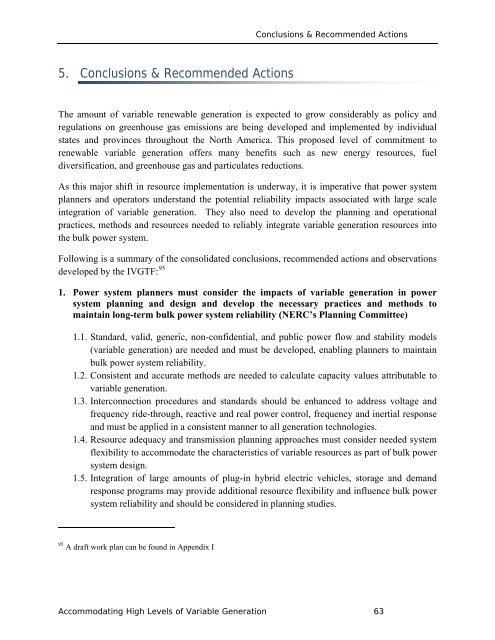Accommodating High Levels of Variable Generation - NERC
Accommodating High Levels of Variable Generation - NERC
Accommodating High Levels of Variable Generation - NERC
Create successful ePaper yourself
Turn your PDF publications into a flip-book with our unique Google optimized e-Paper software.
Conclusions & Recommended Actions<br />
5. Conclusions & Recommended Actions<br />
The amount <strong>of</strong> variable renewable generation is expected to grow considerably as policy and<br />
regulations on greenhouse gas emissions are being developed and implemented by individual<br />
states and provinces throughout the North America. This proposed level <strong>of</strong> commitment to<br />
renewable variable generation <strong>of</strong>fers many benefits such as new energy resources, fuel<br />
diversification, and greenhouse gas and particulates reductions.<br />
As this major shift in resource implementation is underway, it is imperative that power system<br />
planners and operators understand the potential reliability impacts associated with large scale<br />
integration <strong>of</strong> variable generation. They also need to develop the planning and operational<br />
practices, methods and resources needed to reliably integrate variable generation resources into<br />
the bulk power system.<br />
Following is a summary <strong>of</strong> the consolidated conclusions, recommended actions and observations<br />
developed by the IVGTF: 95<br />
1. Power system planners must consider the impacts <strong>of</strong> variable generation in power<br />
system planning and design and develop the necessary practices and methods to<br />
maintain long-term bulk power system reliability (<strong>NERC</strong>’s Planning Committee)<br />
1.1. Standard, valid, generic, non-confidential, and public power flow and stability models<br />
(variable generation) are needed and must be developed, enabling planners to maintain<br />
bulk power system reliability.<br />
1.2. Consistent and accurate methods are needed to calculate capacity values attributable to<br />
variable generation.<br />
1.3. Interconnection procedures and standards should be enhanced to address voltage and<br />
frequency ride-through, reactive and real power control, frequency and inertial response<br />
and must be applied in a consistent manner to all generation technologies.<br />
1.4. Resource adequacy and transmission planning approaches must consider needed system<br />
flexibility to accommodate the characteristics <strong>of</strong> variable resources as part <strong>of</strong> bulk power<br />
system design.<br />
1.5. Integration <strong>of</strong> large amounts <strong>of</strong> plug-in hybrid electric vehicles, storage and demand<br />
response programs may provide additional resource flexibility and influence bulk power<br />
system reliability and should be considered in planning studies.<br />
95 A draft work plan can be found in Appendix I<br />
<strong>Accommodating</strong> <strong>High</strong> <strong>Levels</strong> <strong>of</strong> <strong>Variable</strong> <strong>Generation</strong> 63
















